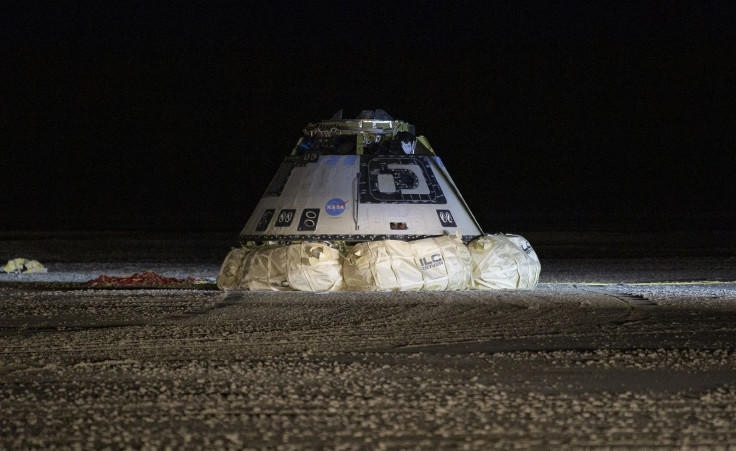Boeing Starliner Completes Successful Landing, Gets The New Name 'Calypso'
KEY POINTS
- Boeing's CST-100 Starliner spacecraft successfully landed in White Sands, New Mexico
- Even though it failed to dock onto the ISS, it completed various other mission objectives
- The failure to dock at the ISS was caused by its on-board clock being out of sync
- Astronauts who will go on the Starliner's next mission gave it the name "Calypso" after the ocean exploring ship
Boeing’s CST-100 Starliner spacecraft completed a successful landing at 7:58 a.m. EST in White Sands, New Mexico on Sunday, Dec. 22. The pre-dawn landing in which the spacecraft landed gently onto its airbags followed a deorbit burn just minutes before at 7:23 a.m., the separation of the service module, and the successful deployment of its main parachutes and airbags.
“Congratulations to the NASA and Boeing teams on a bullseye landing of the Starliner,” NASA Administrator Jim Bridenstine said, noting that the “ hardest parts ” of the flight test were successful.
Apart from the successful landing, other objectives that were met during the Orbital Flight Test include checking the Starliner's NASA Docking System and the spacecraft's propulsion systems, validating the all important environment control and life support systems, testing space-to-space communications and completing a command uplink between the spacecraft and the ISS.
The landing marks the end of Boeing’s uncrewed Orbital Flight Test. The next mission, which will be crewed, is expected to happen sometime in 2020 when the very same Starliner that landed in White sands will fly again.
In fact, upon inspecting the spacecraft, Suni Williams, who will command the crewed mission, announced that they had named it “Calypso” after the ship led by famed explorer Jacque Cousteau.
“We would not be this planet without the ocean. There's so much to discover in the ocean, and there's so much to discover in space," Williams explained.
Clock Glitch
The hope for CST-100 was for it to reach its planned orbit and dock at the International Space Station (ISS). However, the capsule experienced a glitch because its onboard clock was out of sync, causing the spacecraft to think that it was a different time than it actually was. This then caused the Starliner to think that it was already at a different stage of its flight, making it burn more fuel than it should have.
Although mission control attempted to fix the issue from the ground, they were unable to establish a connection in time because of satellite communication link failure. As such, NASA and Boeing were forced to cancel the planned rendezvous with the ISS and return to White Sands instead.
That said, the team is still optimistic about the results of the uncrewed Orbital Flight Test especially since it completed various other objectives related to NASA's Commercial Crew Program.
“This mission has only strengthened the resolve of the NASA, ULA, and Boeing teams. Systems were tested, but more importantly the teams were tested,” NASA Deputy Administrator Jim Morhard said. “The hardest parts of this mission were a tremendous success. The Commercial Crew Program is strong. But keep in mind, this is a great reminder that human exploration is not for the faint of heart. We are just getting started!”
With the Boeing and SpaceX missions, the hope is to soon bring astronauts to the ISS straight from American soil, something that has not been done since 2011.

© Copyright IBTimes 2024. All rights reserved.












